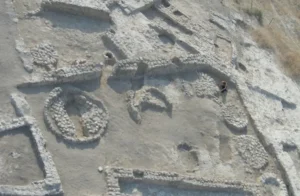Domestication may indicate initial steps in developing a socioeconomic hierarchy supported by administrative system.

Olive trees carry a deep, historical significance in this part of the world, and a recent Israeli study has found some of the earliest evidence for the domestication of the trees from 7,000 years ago.
Analyzing remnants of charcoal from the Chalcolithic site of Tel Tsaf in the Jordan Valley, researchers from Tel Aviv University and the Hebrew University of Jerusalem determined they came from olive trees. Since olive trees did not grow naturally in the Jordan Valley, this means the inhabitants of the site must have planted the trees intentionally about 7,000 years ago, said the researchers.
The discovery and its importance
“Wood was the ‘plastic’ of the ancient world,” a statement from lead researcher Dr. Dafna Langgut of the Jacob M. Alkow Department of Archaeology and Ancient Near Eastern Cultures and the Steinhardt Museum of Natural History at Tel Aviv University explained.
“It was used for construction, for making tools and furniture, and as a source of energy. That’s why identifying tree remnants found at archaeological sites, such as charcoal from hearths, is a key to understanding what kinds of trees grew in the natural environment at the time, and when humans began to cultivate fruit trees.”
Even when burned down to charcoal, trees can be identified by their anatomic structure, she added. As head of the Laboratory of Archaeobotany and Ancient Environments, she specializes in such microscopic identification of plant remains.
The recent study consisted of analyzing charcoal remnants found in the archaeological excavation of Tel Tsaf directed by Prof. Yosef Garfinkel of the Institute of Archaeology at the Hebrew University. The findings were published in the journal Scientific Reports from the publishers of Nature.
Tel Tsaf was a large prehistoric village in the middle Jordan Valley south of Beit She’an, inhabited between 7,200 and 6,700 years ago, noted Garfinkel in the press statement. His excavation revealed large houses with courtyards, each with several granaries for storing crops.
“Storage capacities were up to 20 times greater than any single family’s calorie consumption, so clearly these were caches for storing great wealth. The wealth of the village was manifested in the production of elaborate pottery painted with remarkable skill. In addition, we found articles brought from afar: pottery of the Ubaid culture from Mesopotamia, obsidian from Anatolia, a copper awl from the Caucasus, and more,” he said.
In her lab, Langgut identified the charcoal from Tel Tsaf as belonging to olive and fig trees. Though olive trees grow in the wild in the Land of Israel, they are not native to the Jordan Valley, she said in the statement. So the discovery of olive tree remains in the charcoal indicates that someone brought the trees there intentionally and had enough knowledge about the plant to take it out of its natural habitat and plant it somewhere else, she said.
“In archaeobotany, this is considered indisputable proof of domestication,” she said.
BASED ON THEIR findings, the researchers suggested in their study that the Middle Chalcolithic Tel Tsaf site provides the earliest charred olive wood remains in the Central and Lower Jordan Valley.
In the paper they noted that archaeological and botanical evidence suggest that olive cultivation began in northern Israel along the Carmel coast and in the Galilee toward the end of the eighth millennium, during the Early Chalcolithic period, probably drawing on naturally occurring wild olive species. A few centuries later, according to their findings, at the beginning of the Middle Chalcolithic period around 7000 BCE, the settlers of Tel Tsaf were engaged in full-fledged olive cultivation, said the researchers in their report.
“To accomplish this geographical shift, a transfer of both knowledge and genetic olive material from northern Israel to the Central Jordan Valley must have occurred,” they wrote.
In addition to olive tree remnants, Langgut’s analysis identified many remnants of young fig branches. Fig trees did grow naturally in the Jordan Valley but were of little value for firewood or as raw material for tools or furniture, so there was no reason for people to gather large quantities of branches and bring them to the village, she said.
“Apparently, these fig branches resulted from pruning, a method still used today to increase the yield of fruit trees,” she said.Because of the evidence of exceptional wealth of the settlement exposed in Garfinkel’s excavations, the researchers were not surprised to discover that the inhabitants might have been among the first in the world to intentionally grow olive and fig groves, since growing fruit is an indication of luxury, according to the press statement.Langgut noted that domestication of fruit trees is a process that takes many years. It would therefore logically be used by wealthier societies rather than those struggling to survive and need crops that provide a relatively quick source of food.
“Trees give fruit only three to four years after being planted,” she added. “Since groves of fruit trees require a substantial initial investment, and then live on for a long time, they have great economic and social significance in terms of owning land and bequeathing it to future generations – procedures suggesting the beginnings of a complex society.”
Langgut suggested that the residents of Tel Tsaf might have traded in products derived from the fruit trees such as olives, olive oil and dried figs, all of which have a long shelf life and might have enabled long-distance trade that led to the accumulation of material wealth.
Evidence of the earliest stamps was also found at the site, possibly even indicating a system of taxation and administrative procedures, she noted.
“These may have even been initial steps in turning the locals into a society with a socioeconomic hierarchy supported by an administrative system,” Langgut said. “As a whole, the findings indicate wealth and early steps toward the formation of a complex multilevel society, with the class of farmers supplemented by classes of clerks and merchants.”
